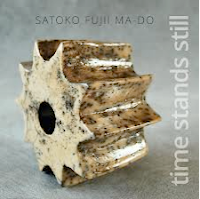Time Stands Still marks the third and final release from the Satoko Fujii Ma-Do Quartet, comprised of Satoko Fujii (piano); Natsuki Tamura (trumpet); Norikatsu Koreyasu (bass) and Akira Horikoshi (drums).
Sadly, bassist Norikatsu Koreyasu suddenly passed away in late September, 2011, at age 56. Given his pivotal role in the group, the decision was made to disband.
The flavor and scope of this album is as poetic as the reality of life’s fleeting beauty. Listeners are gently, yet purposefully pulled through various states of being: here, I am a cloud; there a raging sea; later, I become a blazing fire raging further into the clarity of a calm and knowing breath of wind. And, as in the grander scheme of life, the Listener is at once central and at the periphery.
Overall, the emotional quality is plaintive, pleading, questing and questioning; again, sometimes with thunder, other times, as if wrapped in the slightest whisper. There is a lot of space and a lot of single note/single sound melodic exploration, true to the group’s intention. As explained on Fugii’s website: “Ma-do means window in Japanese. But ma also means the silence between notes. Fujii chose the name to show how the music opens to the outside (just like a window) and that silence can have more meaning than notes.”’ http://www.satokofujii.com/projects.ma-do.html
The group manages to be sparse and dense simultaneously, much like a fine haiku. The way each song links to the next is also very poetic in a macro-sense, perhaps even mirroring the earlier and more complex Japanese poetry form of renku, in which poets work collaboratively in a group to create and link verses. The linear linking from track to track here musically, for me, serves to give the free improv solid context, with the line threaded from beginning to end building, in real time, the structure upon which the musicians weave their complex textures. The album as a whole, then, is quite structured, but organically so.
Each track has its own unique and singular flavor, a testament to the high level musicianship offered to us here. My personal favorite is North Wind and the Sun (Track 2), with a narrative flow that mirrors Aesop’s Fable where the Sun and Wind compete to show the true meaning of strength. The quartet gives us a familiar melodic line that alternates with a sound-based percussive wash, deftly signaling the two characters. Round about 7 minutes, the group suddenly propels into a funky place that morphs into a piano extravaganza of pounding chordal exuberance. This is surprising and, therefore, supremely re-engaging.
Equally surprising is their decision to drive immediately into Track 3, “Time Flies”-- a move that illustrates the organic integrity of this foursome.
The last two tracks are especially interesting, again, even more so because of the way they link together. The adventurous Track 6, Broken Time, proves to be highly varied in rhythmic ideas, and again, becomes suddenly funky mid-stream. Here, the drummer stands out with unique cymbal choices. Some are trashy sounding, and others are very high pitched. Intriguingly, none of them ring out. Horikoshi’s drum tuning is also high-pitched and tight. Broken Time ends with the drummer soloing which is fitting to the subject of the tune as well as sonically arresting.
Next, Track 7, and this song, Time Stands Still, begins with the drums and, again, I am thinking in terms of lines that end in circles. This piece really involves my ear with contrast as Horikoshi switches to some lower sounding toms; but again, they are tuned very tight and dry. The trumpet comes in breathy and soft and low with lots of space and the bowed bass is very low and cello-like; very melancholy. After the piano comes in and they explore for awhile, I wonder, how are they going to get out of this? Slowly, very slowly, Fujii sets off into a series of chords with a very decisive ending point enhanced by the most subtle of decrescendos. The last chord is full of gentle, complex possibility, and like the greatest poetry, this final word leaves the listener yearning.
Read the Liner Notes.
Can be purchased from instantjazz.com
Video, “Fortitude”:

No comments:
Post a Comment
Please note that comments on posts do not appear immediately - unfortunately we must filter for spam and other idiocy.